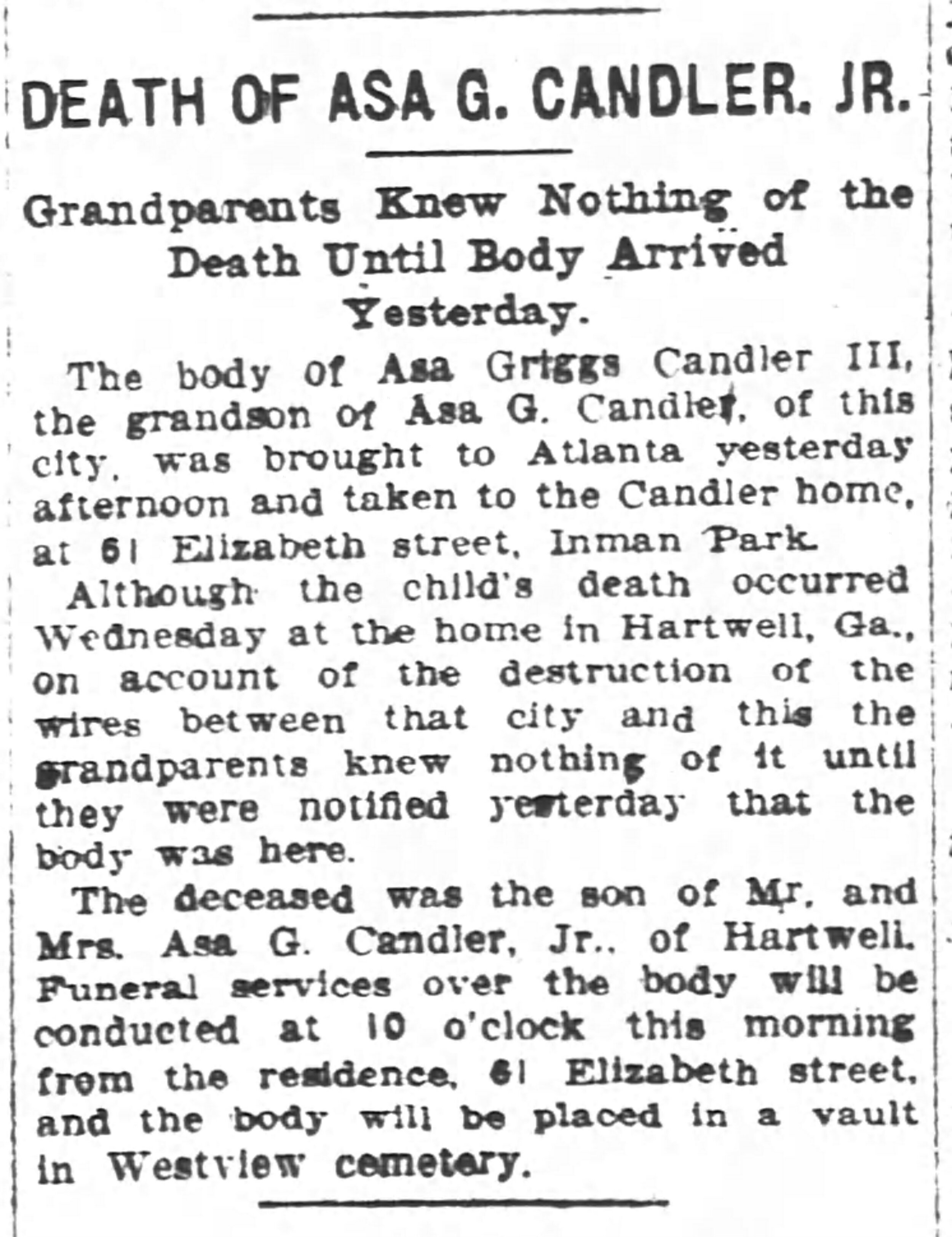Above: Photo of snow storm damage in Atlanta, February 1905. Source: The Atlanta History Center
1905 was a year of winter storms throughout America. In early February a cold front swept across the Southeastern states from Alabama to South Carolina, causing weather damage as far south as northern Florida. On the evening of February 4th, freezing rain descended over Atlanta, glazing every surface in ice. The storm caught the unprepared population by surprise as it coated the roads and caused accidents throughout the city. Falling tree branches tore down telegraph lines, and all transit, including rail, came to a halt. For a major railroad hub, this was a huge disruption.
February 5, 1905, The Atlanta Constitution
February 5, 1905, The Atlanta Constitution
February 5, 1905, The Atlanta Constitution
February 5, 1905, The Atlanta Constitution
Up in the North Georgia foothills, the snow storm hit even harder. All across the northern expanse of the state, residents were snowed and iced in, and roads became completely impassable. These were the conditions that Asa Candler Jr. and his young family faced when they woke up on the morning of February 5th in Hartwell, GA.
By 1905, Asa Jr. and Helen had two children. Lucy-Three was about a month away from turning 4, and her baby brother, Asa-Three, was almost 8 months old. As two of their first three grandchildren, little Lucy and Asa were the joys of Asa Sr. and Lucy Elizabeth’s life. And as the namesake who would carry on the name Asa Griggs Candler, the baby was especially beloved. They visited Atlanta as often as they could to ensure they stayed connected with family, but the distance made traveling an all-day journey on three different rail lines and two transfer points. When the storm hit, all train lines went down, including the narrow gauge Hartwell line that was the only ride out of town.
February 6, 1905, The Atlanta Constitution
Hunkering down and waiting it out was the best approach for most residents, but as the winter storm continued to snap telecom wires and block roads on February 6th and 7th, Asa Jr. and Helen faced a growing crisis. Baby Asa III was sick. Very sick. These were the days before antibiotics and the modern day medicine we take for granted, so all they could do was soothe his symptoms, try to alleviate his discomfort, and pray for the ice to melt enough to grant them passage to the town’s doctor.
Although the storm eased up after a few days, the damage was significant and temperatures held below freezing. From Gainesville to Newnan, and from Athens to Milledgeville, the state was covered in ice. In Atlanta the ice caused pandemonium. Some local phone lines worked, as long as the telephone poles had held up against the storm, but the city was cut off from the outside world, as were most other towns across the state. Some folks ventured out to take in the sights of the frozen city, but mobility was limited to foot traffic. Anything larger slid out of control.
Charles A Kuhns Residence shown with iced trees. Source: The Atlanta History Center
Damage along Piedmont Rd. following the 1905 ice storm. Source: Atlanta History Center
In Hartwell the roads remained impassable, and Asa III’s illness worsened. On February 8th, his little body lost the fight and he passed away. Asa Jr., Helen and Lucy-Three were isolated in North Georgia, grieving alone, hours away from family with no way to contact them and no trains running south. Just like everyone else they had to wait until the storm broke.
Meanwhile, Asa Sr, Lucy Elizabeth, and the rest of the Candler Clan were unaware of their distant family’s tragedy. On the 9th, the sun broke through and forecasts called for the ice to start melting away. With the end in sight, Atlanta celebrated with humor and optimism as the linemen went to work fixing the power lines and telecom connections to the surrounding areas.
February 9, 1905, The Atlanta Constitution
February 10, 1905, The Atlanta Constitution
But progress was slow, and even by February 10th there was still no way to wire a message from Hartwell to Atlanta. Trains started running again, even in the northern reaches of the state. Asa Jr. and Helen faced a decision: should they wait until the lines were back up and telegraph notice of Asa III’s death? Or should they take the first available train and tell their loved ones in person? They chose the latter, desperate with grief for family support. They built a small casket, placed the baby inside, and carried him and little Lucy-Three to the train depot.
First they took the once-a-day narrow gauge line from Hartwell to Bowersville. Then they switched to a full-sized passenger train from Bowersville to Athens. In Athens they caught a connecting line to Atlanta. Leaving in the morning meant arriving in the evening, traveling the whole way with the gravity of their news weighing on them. When they arrived they were able to telephone Asa Jr.’s parents to tell them they were at the train station. When Asa Sr. arrived at the depot, he finally learned that he’d lost his first grandson and namesake. The telegraph wires were reconnected the very next day.
February 11, 1905, The Atlanta Constitution
The Funeral was held at Callan Castle in Inman Park on February 11, 1905. Bishop Warren Candler officiated, as he had done for every family wedding and funeral. Friends of the extended Candler circle were invited to visit and offer their condolences.
February 11, 1905, The Atlanta Constitution
February 11, 1905, The Atlanta Constitution
Of course life went on for the family, as it always does. Asa Jr. and Helen welcomed their next child, John, on December 16, 1905. In total Asa Jr. and Helen had seven children, six of whom survived. Family lore says Asa Jr. wanted to pass his name to his next son but Helen wouldn’t permit him to do so, but it’s impossible to confirm or deny that story. The name ended up passing to Walter, who named his second son Asa IV in 1909. Family lore also claims that Asa Jr. and Walter bickered about the rightful lineage of the name, and Asa Jr. won. His first grandson, born to John, was named Asa V, and the name has remained in his lineage ever since.
Asa III’s loss was felt deeply by the family. In a photo taken in 1909, Asa Sr. and Lucy Elizabeth are shown with all of their children and their families, and at the center of the photo stands a portrait of their lost grandson.
Photo circa 1909
If you would like to visit Asa III’s grave, you can find it next to his father’s at Westview Cemetery. It’s located at the top of the hill beside Mausoleum Row, beneath the large, rectangular Candler memorial.



















